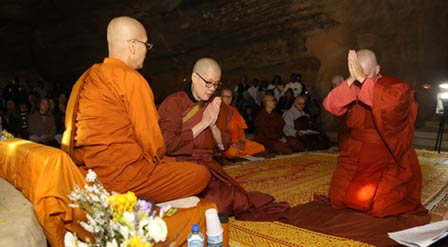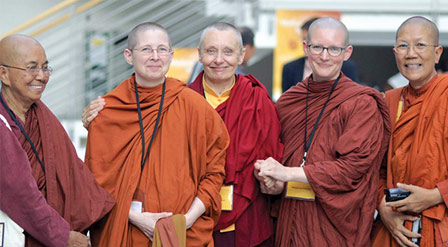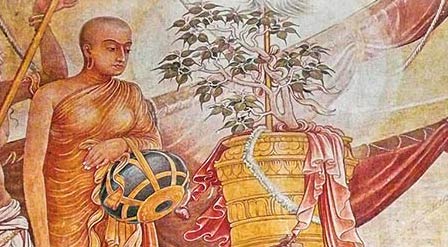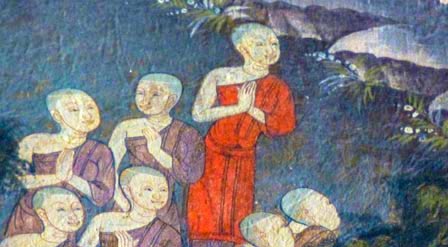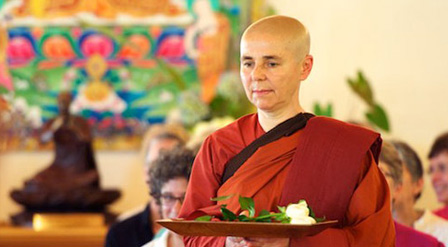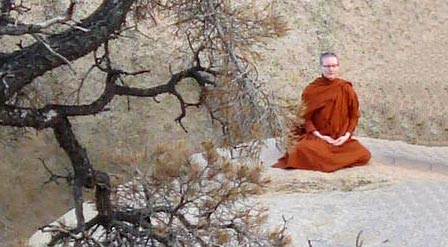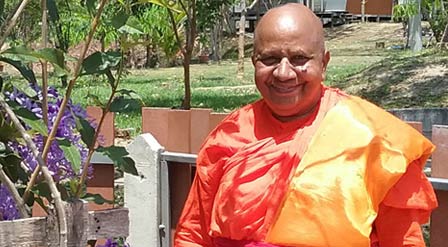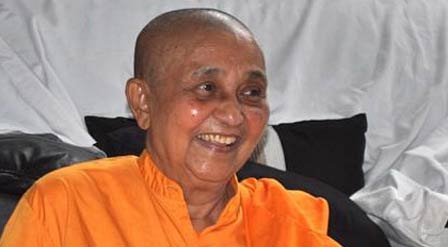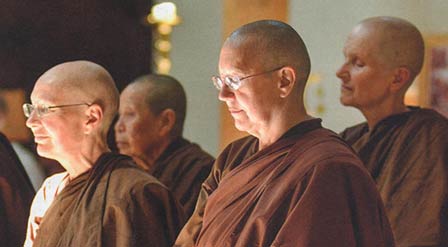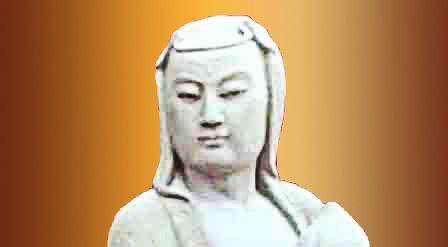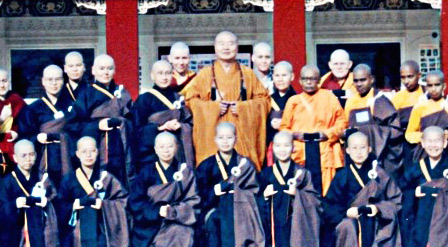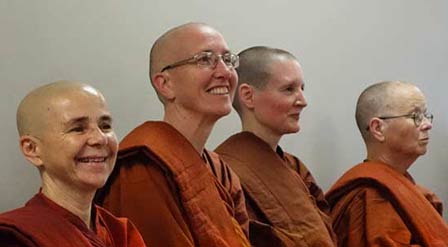Dhammananda Bhikkhuni
A Journey to be a Theravada Bhikkhuni
November 12, 2016
Dhammananda Bhikkhuni
Dhammananda Bhikkhuni
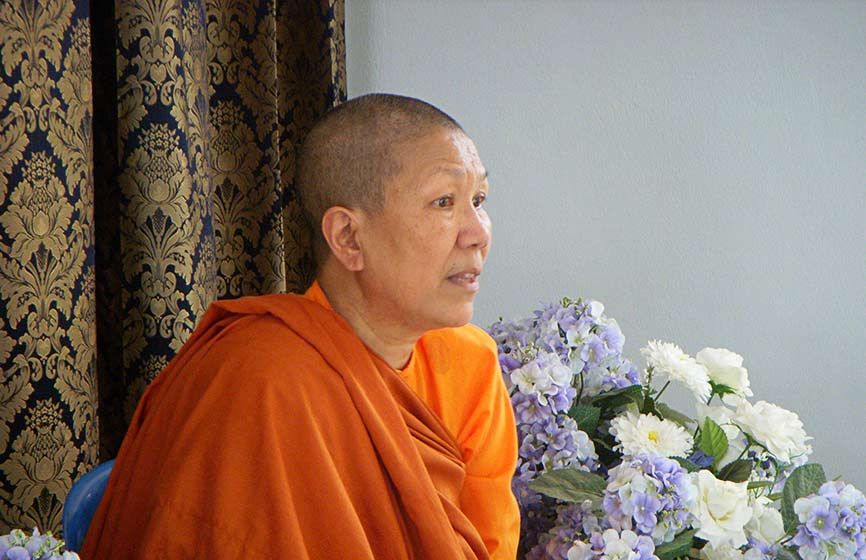
A Journey to be a Theravada Bhikkhuni
November 12, 2016
When my mother shaved her head, I was 11 years old. In Thailand in 1956, if a woman shaved her head, it was to become a mae chee (white robed nun). There was no ordination, just receiving the eight precepts. My mother, Ven. Voramai Kabilingh, never thought of becoming a mae chee—she told her preceptor, Pra Prommuni of Wat Bavornnives, that she would be wearing light yellow—and so it was. She turned her house into a small nunnery where more and more young women joined her. I grew up in this monastic setting, learning all of the chanting along with other nuns. So it is not a surprise that, when I took ordination much later in life, I was already fluent with the chanting.
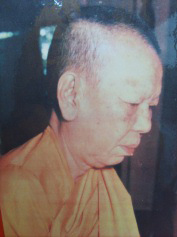
Venerable Voramai Kabilingh, Dhammananda Bhikkhuni’s mother
In the following year, 2500 BE [Buddhist Era, the calendar used in Thailand], which a very important year for Buddhists, I took the light yellow robe and took the precepts from my mother’s teacher at Wat Bavornnives. It was during summer vacation so I remained in the robe for 47 days, until the school started in mid May.
That was my first ordination.
My education prepared me for ordination. I attended McMaster University in Hamilton, Ontario, Canada, where I indulged myself in the study of Buddhism and was converted to a Feminist Buddhist through reading I.B. Horner. My Thesis was “A Comparative Study of Bhikkhuni Patimokkha of 6 Schools.”
The Chinese language, which I had studied while I was in India, really became an asset, as for a Ph.D. one needs to know at least two languages in addition to English. For me, it was Chinese and Sanskrit—I took Sanskrit in the summer to fulfill the other language requirement.
Professor Jan Yun Hua was my mentor and my guide. He suggested my thesis topic, and it was through him that I got an important piece of information—that ordination is still possible. . . in Taiwan.
I arranged the trip to take my mother to Taiwan for bhikshuni ordination in 1971. She became the first Thai woman to become a bhikshuni. At that time in Thailand there were some Chinese women who were bhikshunis, but they lived only in Chinese temples and had limited contact with Thai society. At that time, there was not yet a lineage for Theravada bhikkhuni ordination.
The thought which came to my mind then was, how can I bring about social changes (the theme of the conference), when I am the one who has all the information about bhikkhunis in my hands and my head, and yet I am not doing anything to actually bring about these changes? At this point, I became a change agent, so to say.
After my education, I started working as a lecturer, assistant professor, and then associate professor, at Thammasat University in Bangkok. I spent 27 years in my teaching career. It was during this time, in 1983, that I was first exposed to many western feminists at a conference at Harvard University on women, religion and social changes. I owe my thanks to Professor Diana Eck, the far-sighted organizer—it became a turning point for me to become an activist and work towards the possibility of bhikkhunis in Thailand. The thought which came to my mind then was, how can I bring about social changes (the theme of the conference), when I am the one who has all the information about bhikkhunis in my hands and my head, and yet I am not doing anything to actually bring about these changes? At this point, I became a change agent, so to say.
In 1984 I started a newsletter to link all of the active Buddhist women; it was a quarterly newsletter connecting Buddhist women around the world. I gave the newsletter the name Yasodhara, to honor the Princess who later became an enlightened bhikkhuni. This newsletter worked successfully as a venue for Buddhist women to connect and to learn about each other’s activities. After 30 years, it came to a close in 2014, when I felt that in modern times we can connect through other media and on the internet—including websites and Facebook.
In 1993, the Parliament of World Religions took place in Chicago, on the centenary of the gathering held in 1893. I gave a talk there to some 7000 people. Slowly, I was being exposed to a larger world, which I was yet to get used to.
When I opened myself toward other social activities and did not limit myself only to academic channels, I moved into another area of work—media. From my involvement in an effort to bring about the disrobing of one notorious monk in the Thai sangha, which went on for more than a year, I was spotted on the screen as a possible candidate to run a dharma television program. Yes, I was the first lay Thai woman to be on the screen for a dharma talk show, a space previously monopolized by monks and mae chee. I worked with a private company to bring out a dharma talk show on one of the major TV channels, every Sunday. This work continued for seven years, and twice won an award for the best dharma talk show on television. Towards the end of 2000, I ended this work and prepared myself for ordination.
I became much clearer on my path in the year 2000. In that year, I purposely wanted to mark out my life with something of importance. I recalled attending a workshop where I was asked to draw a river of life, and share important events in life as that river of life flows on—I wanted to mark out an important event in my life.
First, I was committed to leading a life of celibacy and vegetarianism. This was officially marked by taking Bodhisattva precepts from Most Venerable Master Hsing Yun, of Fo Guang Shan, Kaohsiung, Taiwan, in April of 2000. My mother started her temple some 58 years ago, and the main kitchen has always been vegetarian. At first, I knew I should be vegetarian but did not make a commitment. I went through a tug of war—I could not give up the habit of eating meat, but my conscience was getting the better of me. Finally, I could no longer eat meat, as I would develop indigestion and be in much physical discomfort. I had had enough with feeding my body with others’ lives.
The last commitment for which I had to wait was the organization of International Ramayana Conference in December of 2000. Apart from teaching in the department of Philosophy and Religion, I also wore another hat at Thammasat University as the president of the India Studies Program. The conference was under the umbrella of the India Studies Program, for which I was responsible. Once the conference was over, then my work at Thammasat University came to an end. I took early retirement at the end of 2000.
There were two more commitments from which I needed to free myself—I was married with three grown sons. I was considering taking ordination in Taiwan, where candidates who are married must provide a divorce certificate. This is understandable, because at the time of the official ordination, should the husband of one of the candidates protest, the whole ceremony would have to be cancelled. I was supported by my sons, and eventually I obtained the divorce and settled all of the necessary preparations.
Ordination for bhikkhunis was very new in Theravada; it was the ordination of 1998 that was generally accepted. I approached the Most Ven. Sri Sumangalo of Dambulla, however he did not respond. Through the assistance and arrangement of Mrs. Ranjani de Silva, I was first given samaneri ordination by Syamvamsa bhikkhus at Tapodanramaya temple in Colombo. This happened on February 7, 2001. The senior monk who arranged my ordination was Ven. T. Dhammaloka Anunayaka of Amarapura. However, I requested that I would like to take the lineage from Syamvamsa bhikkhus, and he respected my request. My ordained name took after the first part of his name—thus Dhamma—but the latter name is Nanda, representing Ven. Mahapajapati’s daughter, Princess Nanda. I saw myself following the bhikkhuni lineage the same way as Ven. Princess Nanda followed her mother.
From then on, I left behind my former name and attachments, and came to be known as Dhammananda.
Two years after that in, in 2003, I returned to Sri Lanka and was given bhikkhuni ordination. My mother, Ven. Bhikshuni Voramai Kabilsingh, passed away only two months after my full ordination. Thus we can say that our temple, Songdhammakalyani, has always had a bhikkhuni resident from 1971 up to the present.
I am happy to report that now, 15 years after the first day when I took ordination, there are more than 100 bhikkhunis in Thailand. They are scattered across at least 20 provinces representing all of the major regions of the country.
Ven. T. Dhammaloka first resisted my request to be ordained in 2003, saying that he was planning for an international ordination for bhikkhunis in 2004, but somehow I insisted. So I was fully ordained in February of 2003. Sadly, he himself also passed away on December 31, 2003—he did not live to host the international ordination in 2004.
I am happy to report that now, 15 years after the first day when I took ordination, there are more than 100 bhikkhunis in Thailand. They are scattered across at least 20 provinces representing all of the major regions of the country.
With the kindness and thoughtfulness of the Most Ven. Maha Nayaka Mahindavamsa (Dipatuttamaramaya, Colombo) I was appointed also as the first Pavattini for Theravada bhikkhunis in Thailand on November 29, 2014. The appointment was done in front of 20 bhikkhus and 12 bhikkhunis at Thippayasathandhamma Bhikkhuni Arama in Songkhla, Thailand.
In September 2016, through the Network of Asian Theravada Bhikkhunis and many other organizations, we successfully organized the ASEAN (Association of Southeast Asian Nations) Buddhist Conference in Nakhonpathom Rajbhat University. Papers from 22 countries were presented, helping to build a network of Buddhists to promote Buddhism in each land.
At Songdhammakalyani, the monastic training is scheduled in June every year. Sponsorship is provided for nuns to come from third world countries. Also, regular samaneri ordination is organized twice a year. I am happy to report that we are slowly building the foundation for Buddhist women to come forward and take responsibility in helping to spread the teaching of the Buddha far and wide into the future.
Header photo courtesy of Carol Annable
When my mother shaved her head, I was 11 years old. In Thailand in 1956, if a woman shaved her head, it was to become a mae chee (white robed nun). There was no ordination, just receiving the eight precepts. My mother, Ven. Voramai Kabilingh, never thought of becoming a mae chee—she told her preceptor, Pra Prommuni of Wat Bavornnives, that she would be wearing light yellow—and so it was. She turned her house into a small nunnery where more and more young women joined her. I grew up in this monastic setting, learning all of the chanting along with other nuns. So it is not a surprise that, when I took ordination much later in life, I was already fluent with the chanting.

Venerable Voramai Kabilingh, Dhammananda Bhikkhuni’s mother
In the following year, 2500 BE [Buddhist Era, the calendar used in Thailand], which a very important year for Buddhists, I took the light yellow robe and took the precepts from my mother’s teacher at Wat Bavornnives. It was during summer vacation so I remained in the robe for 47 days, until the school started in mid May.
That was my first ordination.
My education prepared me for ordination. I attended McMaster University in Hamilton, Ontario, Canada, where I indulged myself in the study of Buddhism and was converted to a Feminist Buddhist through reading I.B. Horner. My Thesis was “A Comparative Study of Bhikkhuni Patimokkha of 6 Schools.”
The Chinese language, which I had studied while I was in India, really became an asset, as for a Ph.D. one needs to know at least two languages in addition to English. For me, it was Chinese and Sanskrit—I took Sanskrit in the summer to fulfill the other language requirement.
Professor Jan Yun Hua was my mentor and my guide. He suggested my thesis topic, and it was through him that I got an important piece of information—that ordination is still possible. . . in Taiwan.
I arranged the trip to take my mother to Taiwan for bhikshuni ordination in 1971. She became the first Thai woman to become a bhikshuni. At that time in Thailand there were some Chinese women who were bhikshunis, but they lived only in Chinese temples and had limited contact with Thai society. At that time, there was not yet a lineage for Theravada bhikkhuni ordination.
The thought which came to my mind then was, how can I bring about social changes (the theme of the conference), when I am the one who has all the information about bhikkhunis in my hands and my head, and yet I am not doing anything to actually bring about these changes? At this point, I became a change agent, so to say.
After my education, I started working as a lecturer, assistant professor, and then associate professor, at Thammasat University in Bangkok. I spent 27 years in my teaching career. It was during this time, in 1983, that I was first exposed to many western feminists at a conference at Harvard University on women, religion and social changes. I owe my thanks to Professor Diana Eck, the far-sighted organizer—it became a turning point for me to become an activist and work towards the possibility of bhikkhunis in Thailand. The thought which came to my mind then was, how can I bring about social changes (the theme of the conference), when I am the one who has all the information about bhikkhunis in my hands and my head, and yet I am not doing anything to actually bring about these changes? At this point, I became a change agent, so to say.
In 1984 I started a newsletter to link all of the active Buddhist women; it was a quarterly newsletter connecting Buddhist women around the world. I gave the newsletter the name Yasodhara, to honor the Princess who later became an enlightened bhikkhuni. This newsletter worked successfully as a venue for Buddhist women to connect and to learn about each other’s activities. After 30 years, it came to a close in 2014, when I felt that in modern times we can connect through other media and on the internet—including websites and Facebook.
In 1993, the Parliament of World Religions took place in Chicago, on the centenary of the gathering held in 1893. I gave a talk there to some 7000 people. Slowly, I was being exposed to a larger world, which I was yet to get used to.
When I opened myself toward other social activities and did not limit myself only to academic channels, I moved into another area of work—media. From my involvement in an effort to bring about the disrobing of one notorious monk in the Thai sangha, which went on for more than a year, I was spotted on the screen as a possible candidate to run a dharma television program. Yes, I was the first lay Thai woman to be on the screen for a dharma talk show, a space previously monopolized by monks and mae chee. I worked with a private company to bring out a dharma talk show on one of the major TV channels, every Sunday. This work continued for seven years, and twice won an award for the best dharma talk show on television. Towards the end of 2000, I ended this work and prepared myself for ordination.
I became much clearer on my path in the year 2000. In that year, I purposely wanted to mark out my life with something of importance. I recalled attending a workshop where I was asked to draw a river of life, and share important events in life as that river of life flows on—I wanted to mark out an important event in my life.
First, I was committed to leading a life of celibacy and vegetarianism. This was officially marked by taking Bodhisattva precepts from Most Venerable Master Hsing Yun, of Fo Guang Shan, Kaohsiung, Taiwan, in April of 2000. My mother started her temple some 58 years ago, and the main kitchen has always been vegetarian. At first, I knew I should be vegetarian but did not make a commitment. I went through a tug of war—I could not give up the habit of eating meat, but my conscience was getting the better of me. Finally, I could no longer eat meat, as I would develop indigestion and be in much physical discomfort. I had had enough with feeding my body with others’ lives.
The last commitment for which I had to wait was the organization of International Ramayana Conference in December of 2000. Apart from teaching in the department of Philosophy and Religion, I also wore another hat at Thammasat University as the president of the India Studies Program. The conference was under the umbrella of the India Studies Program, for which I was responsible. Once the conference was over, then my work at Thammasat University came to an end. I took early retirement at the end of 2000.
There were two more commitments from which I needed to free myself—I was married with three grown sons. I was considering taking ordination in Taiwan, where candidates who are married must provide a divorce certificate. This is understandable, because at the time of the official ordination, should the husband of one of the candidates protest, the whole ceremony would have to be cancelled. I was supported by my sons, and eventually I obtained the divorce and settled all of the necessary preparations.
Ordination for bhikkhunis was very new in Theravada; it was the ordination of 1998 that was generally accepted. I approached the Most Ven. Sri Sumangalo of Dambulla, however he did not respond. Through the assistance and arrangement of Mrs. Ranjani de Silva, I was first given samaneri ordination by Syamvamsa bhikkhus at Tapodanramaya temple in Colombo. This happened on February 7, 2001. The senior monk who arranged my ordination was Ven. T. Dhammaloka Anunayaka of Amarapura. However, I requested that I would like to take the lineage from Syamvamsa bhikkhus, and he respected my request. My ordained name took after the first part of his name—thus Dhamma—but the latter name is Nanda, representing Ven. Mahapajapati’s daughter, Princess Nanda. I saw myself following the bhikkhuni lineage the same way as Ven. Princess Nanda followed her mother.
From then on, I left behind my former name and attachments, and came to be known as Dhammananda.
Two years after that in, in 2003, I returned to Sri Lanka and was given bhikkhuni ordination. My mother, Ven. Bhikshuni Voramai Kabilsingh, passed away only two months after my full ordination. Thus we can say that our temple, Songdhammakalyani, has always had a bhikkhuni resident from 1971 up to the present.
I am happy to report that now, 15 years after the first day when I took ordination, there are more than 100 bhikkhunis in Thailand. They are scattered across at least 20 provinces representing all of the major regions of the country.
Ven. T. Dhammaloka first resisted my request to be ordained in 2003, saying that he was planning for an international ordination for bhikkhunis in 2004, but somehow I insisted. So I was fully ordained in February of 2003. Sadly, he himself also passed away on December 31, 2003—he did not live to host the international ordination in 2004.
I am happy to report that now, 15 years after the first day when I took ordination, there are more than 100 bhikkhunis in Thailand. They are scattered across at least 20 provinces representing all of the major regions of the country.
With the kindness and thoughtfulness of the Most Ven. Maha Nayaka Mahindavamsa (Dipatuttamaramaya, Colombo) I was appointed also as the first Pavattini for Theravada bhikkhunis in Thailand on November 29, 2014. The appointment was done in front of 20 bhikkhus and 12 bhikkhunis at Thippayasathandhamma Bhikkhuni Arama in Songkhla, Thailand.
In September 2016, through the Network of Asian Theravada Bhikkhunis and many other organizations, we successfully organized the ASEAN (Association of Southeast Asian Nations) Buddhist Conference in Nakhonpathom Rajbhat University. Papers from 22 countries were presented, helping to build a network of Buddhists to promote Buddhism in each land.
At Songdhammakalyani, the monastic training is scheduled in June every year. Sponsorship is provided for nuns to come from third world countries. Also, regular samaneri ordination is organized twice a year. I am happy to report that we are slowly building the foundation for Buddhist women to come forward and take responsibility in helping to spread the teaching of the Buddha far and wide into the future.
Header photo courtesy of Carol Annable

